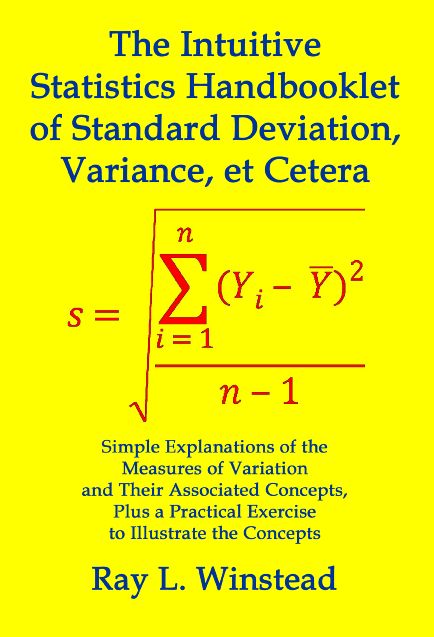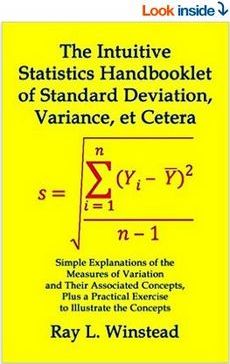|
The Intuitive Statistics Handbooklet of Standard Deviation, Variance, et Cetera |
Simple Explanations
of the Measures of Variation and Their Associated Concepts,
Plus a Practical Exercise to Illustrate the Concepts
Ray L.
Winstead

Order this 55-page handbooklet from Amazon.com
by clicking on either image of the cover of the book
Book Description
This 55-page "handbooklet"
is intended for anyone at any level who wishes to have more intuitive
explanations of the concepts of standard deviation and variance, as well
as a better understanding of their formulas and associated concepts.
(Total of 66 pages.)
Part 1 explains the concepts of standard deviation and variance as
measures of variation.
Section I.1: Introduction and the Mean
Section I.2: Standard Deviation of a Population Characteristic
Section I.3: Standard Deviation of a Sample Characteristic
Section I.4: Variance
Part 2 explains some additional statistical concepts specifically
associated with standard deviation and variance, such as degrees of
freedom.
Section II.1: Unbiased and Biased Estimate
Section II.2: Degrees of Freedom
Section II.3: Distribution of Measurement Values
Section II.4: Point Estimate, Confidence Interval Estimate, and Standard
Error of an Estimate
Section II.5: Independent Variable and Dependent Variable
Part 3 provides a practical exercise to demonstrate the concepts of
standard deviation and variance, as well as simple statistical tests,
such as the t-test and F-test, to compare the characteristics between
two groups. Strength of Association Measures are also examined.
Section III.1: Introduction to the Exercise and Calculations to Obtain
the Standard Deviation and Variance
Section III.2: Comparing Two Groups
Section III.3: Strength of Association Measure
Part 4 provides information about Research Procedure.
Section IV.1: Outline of Research Procedure
Section IV.2: Null Hypothesis and “p value”
In addition to the explanations of standard deviation, variance, and
some other concepts directly associated with these measures of
variation, additional statistical concepts are mentioned to lead and
encourage the reader to further explore the details of those useful
statistical tools that are beyond the scope of this little “handbooklet.”

